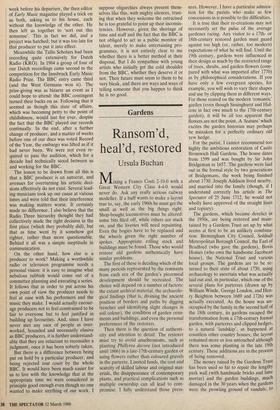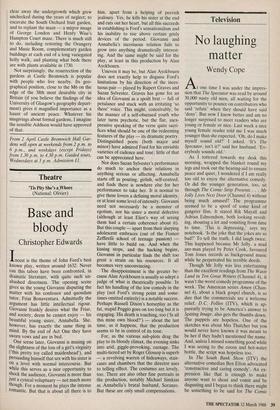Gardens
Ransom'd, heal'd, restored
Ursula Buchan
Mixing a Franco Costi 2-10-0 with a Great Western City Class 4-4-0 would never do. Ask any really serious railway modeller. If a buff wants to make a layout true to, say, the early 1960s he must get the small as well as the big things right. Shop-bought locomotives must be altered: some bits filed off, while others are stuck on, and the liveries will need repainting. Even the bogies have to be replaced and the wheels given the right number of spokes. Appropriate rolling stock and buildings must be found. Those who would restore old gardens authentically have similar problems.
The first of these is deciding which of the many periods represented by the remnants from each era of the garden's piecemeal development should be recreated. The choice will depend on a number of factors: the extant archival material, the archaeolo- gical findings (that is, divining the ancient position of borders and paths by digging trenches and identifying slight changes in soil colour), the condition of garden orna- ments and buildings, and even the personal preferences of the restorers.
Then there is the question of authenti- city and attention to detail. The restorer must try to avoid anachronisms, such as planting Phillyrea decora (not introduced until 1866) in a late-17th-century garden or using flowers rather than coloured gravels in the parterre. Limited funds, the cost and scarcity of skilled labour and original mat- erials, the disappearance of contemporary plants, and practical complications such as multiple ownership can all lead to com- promise. I fully understand those press- ures. However, I have a particular admira- tion for the purists who make as few concessions as is possible to the difficulties.
It is true that their re-creations may not necessarily set the pulse of the average gardener racing. Any visitor to a 17th- or 18th-century restored garden must guard against too high (or, rather, too modern) expectations of what he will find. Until the 19th century, gardens were influenced in their design as much by the restricted range of trees, shrubs, and garden flowers (com- pared with what was imported after 1770) as by philosophical considerations. If you have only a few evergreen species, for example, you will wish to vary their shapes and use by clipping them in different ways. For those reared on the modern 'romantic' garden (even though Sissinghurst and Hid- cote in fact owe much to the 17th-century garden), it will be all too apparent that flowers are not the point. A 'feature' which excites the garden historian may perhaps be mistaken for a perfectly ordinary old yew hedge.
For the purist, I cannot recommend too highly the ambitious restoration of Castle Bromwich Hall Gardens. The house dates from 1599 and was bought by Sir John Bridgeman in 1657. The gardens were laid out in the formal style by two generations of Bridgemans, the work being finished about 1730. Joseph Addison lived nearby, and married into the family (though, if I understand correctly his article in The Spectator of 25 June 1712, he would not wholly have approved of the straight lines and topiary).
The gardens, which became derelict in the 1950s, are being restored and main- tained by a Gardens Trust set up by what seems at first to be an unlikely combina- tion: Birmingham City Council, Solihull Metropolitan Borough Council, the Earl of Bradford (who gave the gardens), Bovis Homes (who own the handsome Jacobean house), the National Trust and various local groups. The gardens are to be re- turned to their state of about 1730, using archaeology to ascertain what was actually laid out and, in particular, which one of the several plans for parterres (drawn up by William Winde, George London, and Hen- ry Beighton between 1689 and 1726) was actually executed. As the house was un- occupied by the family in the second half of the 18th century, its gardens escaped the transformation from a 17th-century formal garden, with parterres and clipped hedges, to a natural landskip', as happened at countless other country houses; the layout remained more or less untouched although there was some planting in the late 19th century. These additions are in the process of being removed.
The money raised by the Gardens Trust has been used so far to repair the lengthY park wall (with handmade bricks and lime mortar) and the garden buildings, much damaged in the 30 years when the gardens were the prowling ground of vandals; to clear away the undergrowth which grew unchecked during the years of neglect; to excavate the South Orchard fruit garden, and to replant the maze — a miriror image of George London and Henty Wise's Hampton Court maze. There is much still to do, including restoring the Orangery and Music Room, complementary garden buildings at each end of a long variegated holly walk, and planting what beds there are with plants available in 1730.
Not surprisingly, the resurrection of the gardens at Castle Bromwich is popular with people who live nearby. Its geo- graphical position, close to the M6 on the edge of the 38th most desirable city in Britain (if you believe the findings of the University of Glasgow's geography depart- ment) gives it magnified importance as a haunt of ancient peace. Whatever his misgivings about formal gardens, I imagine the sensible Addison would have approved of that.
From 2 April Castle Bromwich Hall Gar- dens will open at weekends from 2 p.m. to 6 p.m., and weekdays (except Fridays) from 1.30 p.m. to 4.30 p.m. Guided tours, Wednesdays at 3 p.m. Admission fl.



















































 Previous page
Previous page